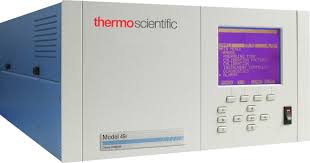Instrument Support Level 3
Thermo Scientific 49i-PS Ozone Primary Standard
Not Applicable
Calendar

Model 49i-PS Ozone Primary Standard
The Thermo 49i PS Ozone Calibrator generates ozone using UV photolysis of O2 at 185 nm and measures ozone by using a dual cell UV photometric gas analyser.
The instrument is manufactured by Thermo Scientific (Model 49i-PS).
Custom Ranges: 0 to 0.05 to 5ppm and 0 to 0.1 to 10µg/m3
Flow Rate: 1 to 3L/min.
Linearity: ±1% full scale
Lower Detectable Limit: 1.0ppb
Precision: 1ppb
Inputs: 16 Digital inputs (standard), 8 0 to 10VDC analog
Preset Measurement Ranges : 0-0.05, 0.1, 0.2, 0.5, 1.0, 0.2, 0.5, 1.0, 2.0, 5.0ppm
Response Time: 20 seconds (10 second lag time)
Temperature (Metric) Operating: 0° to 45°C
Voltage: 100 to 115VAC; 220 to 240VAC
The instrument is calibrated annually using the primary standard reference photometer #2 (SRP#2) from the National Physical Laboratory (NPL) (traceable through the National Institute of Standards and Technology (NIST). This allows the bias on a full range of ozone values to be evaluated.
This instrument is run as part of the COZI Laboratory set-up. It is run almost continuously to enable information about its long-term stability to be obtained. The instrument is calibrated regularly and is traceable to the Global Atmospheric Watch scale. Users are invited to calibrate their ozone instruments using this facility.
Ozone is generated by UV photolysis of O2 at 185 nm and measured by a dual cell UV photometric gas analyser. The instrument is manufactured by Thermo Scientific (Model 49i-PS).
To measure the ozone concentration generated, the sample air is drawn continuously through an optical absorption cell where it is irradiated by monochromatic light at 253.7 nm from a stabilized low-pressure Hg discharge lamp. The absorption of this radiation by the sample air is a measure of the ambient air ozone concentration. To avoid interference from other gases absorbing light at the same wavelength and from instability in the light source, an ozone catalytic converter is used to selectively remove ozone from the sample stream either in the sample cell by using another parallel sample cell.
The Beer-Lambert equation, shown below, is used to calculate the concentration of ozone from the ratio of the two light intensities measured:
I/I0=e-acd
Where,
I0 is the light intensity measured with no ozone in the gas sample
I is the light intensity measured with ozone in the gas sample
a is the ozone absorption coefficient at 253.7 nm (1.44 x 10-5 m2/mg)
c is the mass concentration of ozone in mg/m3
d is the optical path length in m
The instruments’ parameters (cell pressure, flows, intensities, etc) are logged continuously to allow long-term evaluation of the instrument.
The instrument is calibrated annually using the primary standard reference photometer #2 (SRP#2) from the National Physical Laboratory (NPL) (traceable through the National Institute of Standards and Technology (NIST). This allows the bias on a full range of ozone values to be evaluated.
Data from instruments that are part of a laboratory do not archive their data to CEDA and so do not have to conform to any AMOF standard.
Generated ozone data (ppbv) and parameter data from the calibrator can be provided for the period of time that the user has accessed the facility.
